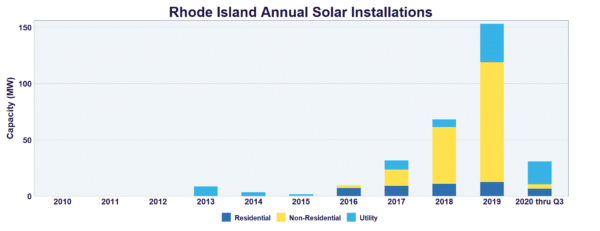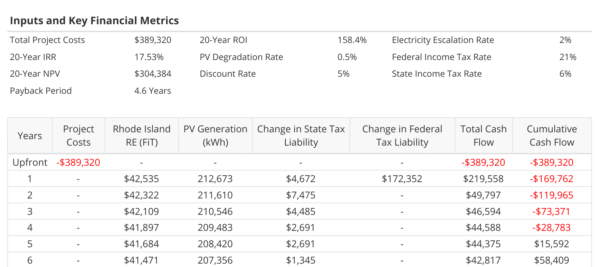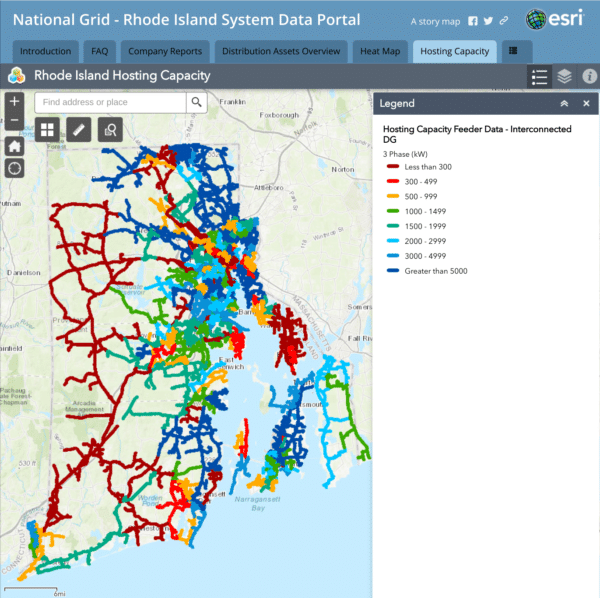In January 2020, Rhode Island Gov. Gina Raimondo signed an executive order directing the state’s electricity mix to become 100% renewable by 2030.
By the end of the third quarter of last year, the state had installed 351 MW of solar power (in more than 7,000 unique installations), 25 MW of offshore wind power, and 140 MW of onshore wind. Additionally, a contract for the 400 MW Mayflower offshore wind farm was signed.

Image: SEIA
More than three-quarters of the state’s solar is small-scale, according to the Energy Information Administration, part of the U.S. Energy Department. It stands to reason that the smallest U.S. state should have relatively few large-scale ground-based solar projects!
pv magazine USA has covered Rhode Island solar NIMBY-ism multiple times, so we thought it appropriate to cover what is arguably the state’s most successful solar program. The Rhode Island Renewable Energy Growth (REGrowth) program offers a 20-year feed-in tariff for non-residential renewable energy projects sized between 25 kW and 5 MW.
To optimize the price of electricity paid by electricity users, project owners bid their project price per kilowatt-hour up to a ceiling amount that is designed to creep downward slowly every year.
Standalone
The program structure requires that each solar project be a standalone system. That means it has to have its own electricity meter and sell 100% of its power directly to the electric utility. For the 2020 procurement year, the state’s goal was to deploy 40 MW of renewable energy capacity, with solar vying to grab as much of that as it could.
When presenting the financial model of an REGrowth project to a building owner, two aspects really drive the process.

First and foremost, the solar project must provide an attractive return on investment. An ideal solar installation on a Rhode Island commercial rooftop could be fully paid off and in the black after 4.6 years (including tax benefits), as shown in the table. More complicated projects could take up to 7 years–still a seductive opportunity.
A second big factor is the 20-year, fixed contract between the rooftop owner and the electric utility, which is backed by the state itself. This structure helps banks feel secure when it comes to project underwriting.
As already noted, these systems are required to have their own electricity meter. Thus, they’re an asset with a revenue stream that provides a direct deposit once a month into a known, fixed, bank account (which can be captured by law if need be). If a project is priced well, then the revenue should generate enough to cover the note, even if the customer runs away with the tax benefits.
Program nuance
This standalone electric meter requirement adds a nuance that allows some installations to generate more energy from solar than their occupants use. This maximizes solar generation capacity, while also lowering the average cost per solar installation due to economies of scale.
So, under a standard net metering/behind-the-meter program, a building owner/occupant that uses 100,000 kWh/year would be able to install only about 80 kW of solar power. That capacity roughly matches the building’s annual usage.
However, the REGRowth program lets owner/occupants produce as much solar as the roof can support, with 100% of the energy sold to the power grid.
This is a greatly under-appreciated aspect of the program. In this author’s professional (and tax-paying citizen’s) opinion, it should be adopted nationwide!
Challenges
The program’s main challenges have to do with timing, risk capital, and the confidence business owners have when asked to invest up to seven figures in energy and efficiency upgrades.
First, customers must apply for interconnection to the utility, which for most of Rhode Island is National Grid. If the customers feel the project risk is low, then they apply for interconnection. The process costs a few thousand dollars and typically takes some months to complete.

Even with risk perception mitigated via insights gained by a utility-provided hosting capacity map, this part of the process isn’t without its unknowns. For example, an interconnection application might come back saying that large upgrades are needed, or that a project installation can’t occur for years. After all, National Grid has had challenges projecting new solar power volume in the New England power grid region.
Then, once the interconnection work is complete, the owner/occupant can apply for the REGrowth program. This step allows the applicant to finalize what the expected payback will be and ultimately learn whether the project has been accepted into the program.
Building confidence
Customer must have confidence that they have bid well, that their building can handle the added weight of the solar, and that their grid connection will not require upgrade improvements whose cost often kills project finances.
Generally, business owners are open to accepting risks and unknowns. However, they mostly want unknowns that lie within the realms of their expertise. Obviously, though, projects are being installed, which suggests that solar developers are able to bridge both the trust and the risk gaps.
Overall, the program seems to be installing a decent amount of rooftop solar power at rates that benefit local business and with great transparency. However, it is likely that the process’s slow progress from project conception to interconnection, and ultimately to grid connectivity, has slowed Rhode Island’s much-needed clean energy deployment.
John Fitzgerald Weaver is a solar power professional, known digitally as the ‘Commercial Solar Guy.’ His company has a construction license in Massachusetts, and directly manages projects in MA & RI. He may be reached at commercialsolarguy@gmail.com
The views and opinions expressed in this article are the author’s own, and do not necessarily reflect those held by pv magazine.
This content is protected by copyright and may not be reused. If you want to cooperate with us and would like to reuse some of our content, please contact: editors@pv-magazine.com.








Thank you, this was very helpful and indeed saved me a lot of time!